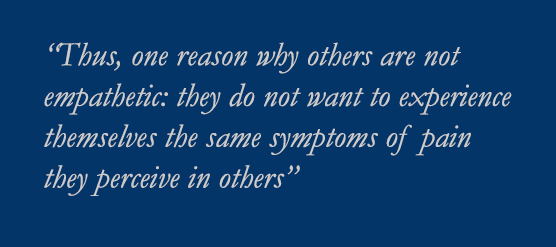Tapping into the empathy of others can at times seem elusive. We’ve all seen instances where one would expect empathy to arise spontaneously––for example, in response to another’s injury––but just the opposite occurs. Instead of empathy there’s a distinct closing off of emotion, a hardening and desensitization. Why? What is it that shuts down the reflex in others to share and understand another’s pain?
Over the years a number of explanations have been suggested. One such explanation is known as “mind-blindness”: “Mind-blindness is a cognitive disorder where an individual is unable to attribute mental states to others. As a result of this kind of social and empathetic cognitive deficit, the individual is incapable in putting himself “into someone else’s shoes” and cannot conceptualize, understand or predict knowledge, thoughts and beliefs, emotions, feelings and desires, behaviour, actions and intentions of another person. Such an ability to develop a mental awareness of what is in the other minds is known as the Theory of Mind (ToM), and the “Mind-blindness” Theory asserts that children who delay in this development often are or will be autistic and Asperger’s syndrome (AS) patients. In addition to autism and AS, ToM and mind-blindness research has recently been extended to other disorders such as schizophrenia, dementia, bipolar disorders, antisocial personality disorders as well as normal aging.”[1]
“As well as normal aging.” One would think that the natural process of aging should give rise to a greater degree of empathy, but just the opposite can occur. A lack of empathy is best seen as a protective device, a means to prevent the same harm from occurring to oneself. In fact, there’s medical literature describing MRI studies showing the same regions of the brain which process pain are triggered when participants are shown photographs of others in situations likely to cause pain: “The results demonstrated that perceiving and assessing painful situations in others was associated with significant bilateral changes in activity in several regions notably, the anterior cingulate, the anterior insula, the cerebellum, and to a lesser extent the thalamus. These regions are known to play a significant role in pain processing.”[2] Thus, one reason why others are not empathetic: they do not want to experience themselves the same symptoms of pain they perceive in others.
“To perceive is to suffer,” wrote Aristotle. Once this phenomenon is recognized steps can be taken to lessen its effect. One such step is “deflection”––suggesting that the harm shown is due to the fault of another. Another such step is “distancing”––suggesting that an arm’s length approach be utilized. This latter may seem a bit counterintuitive. It would seem that the more compassion one can generate the better, and while that’s true to a certain extent, it’s also true that the protective mechanisms closing off the empathetic response are easily triggered. Thus, a more nuanced approach––to reach close to the line but never to cross it.
[1] Mind-blindness, Wikipedia, https://en.wikipedia.org/wiki/Mind-blindness
[2] Philip L. Jackson, Andrew N. Meltzoff, Jean Decety, How Do We Perceive the Pain of Others? A Window Into the Neural Processes Involved in Empathy, NeuroImage, 24 (2005) 771-779 (“Our results demonstrate that the anterior cingulate and anterior insula cortices, regions often reported as being part of the pain affective system, are recruited when watching someone else’s pain.”).




